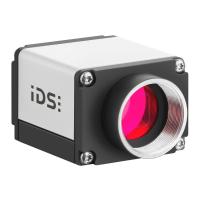© 2009 IDS Imaging Development Systems GmbH 85
8 Applications
Not enough destination memory
allocated or all destination buffers locked
by the application
· Reduce the frame rate so that there is more time to
process the filled destination buffers
Internal error during internal processing
of the image
All destination buffers locked by the
application
· Reduce the frame rate so that there is more time to
process the filled destination buffers
The computer takes too long to process
the images in the uEye API (e.g. colour
conversion)
· Reduce the frame rate so that there is more time to
process the filled image memory of the driver
· Disable resource-intensive API image pre-processing
functions (e.g. edge enhancement, colour correction,
choose smaller filter mask for software colour
conversion)
The camera was disconnected or closed
Not enough free bandwidth for image
transfer available on the USB bus
· Reduce the pixel clock frequency
· Operate fewer cameras simultaneously on a USB
bus
· Check the quality of the USB cabling and
components
The selected timeout value is too low for
image captre
· Reduce the exposure time
· Increase the timeout
The data rate of the sensor is too high
· Reduce the pixel clock frequency
· Reduce the frame rate
· Reduce the AOI
The camera's frame rate is too high or
the bandwidth on the network is
insufficient to transfer the image
· Reduce the frame rate
· Increase the value for the receive descriptors in the
network card settings

